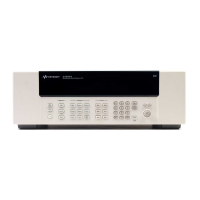Breadboard Module 13
34980A User’s Guide 331
Example: If the Breadboard Module is in slot 4, and channels 001 and 002
have been configured as a word input, the following command returns the
value of the combined channel word as an integer:
SENSe:DIGital:DATA:WORD? (@4001)
Example: If the Breadboard Module is in slot 6, and channel 001 has been
configured as a byte input, the following command returns the state of bit
4 on the channel 001 byte:
SENSe:DIGital:DATA:BIT? 4,(@6001)
Write Command Syntax
Before writing digital data to the breadboard outputs, you must first
configure the digital channel width as byte or word, using the same
commands listed under “Read Command Syntax” on page 330.
After either channel has been configured as a byte, or both have been
configured as a word, you must then specify the target channel for output
operations, using the
CONFigure:DIGital:DIRection command. The
syntax is the same as for input operations, except for the specified
<direction>.
Example: If the Breadboard Module is in slot 3, and channel 002 has been
configured as a byte, the following command configures channel 002 as a
byte- width output:
CONFigure:DIGital:DIRection OUTPut, (@3002)
Example: If the Breadboard Module is in slot 5, and both channels have
been configured as a word, the following command configures the
combined channel as a word- width output (note that it is only necessary
to specify the first channel in SCPI, once the two channels have been
configured as a word):
CONFigure:DIGital:DIRection OUTPut, (@5001)
Once the data width and direction have been configured, the data (either
word, byte or bit) is written to the output lines using the SOURce
command. The syntax of that command is subtly different for writing a
single bit versus writing an entire byte or word.
To output a digital bit, the specified bit number must be 0 (LSB) through
7 (MSB) of the targeted byte, and the syntax is:
SOURce:DIGital:DATA:BIT {0|1}, <bit>, (@<ch_list>)

